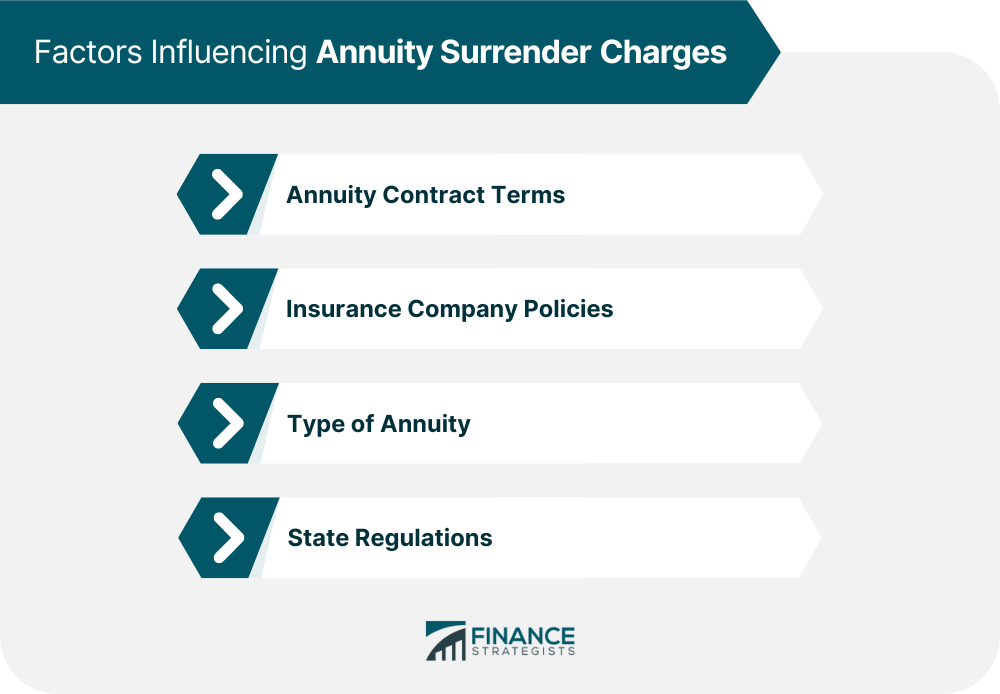Annuity surrender charges are fees imposed by insurance companies when an annuity owner withdraws a portion or all of their funds before the contract's surrender period ends. Annuities are long-term financial contracts between an individual and an insurance company designed to provide a steady stream of income during retirement. In exchange for a lump sum payment or a series of premium payments, the insurance company guarantees the individual a certain amount of income for a specified period or for the rest of their life. The primary purpose of annuities is to provide financial security during retirement by offering a reliable source of income. Annuities can help individuals maintain their desired standard of living, hedge against the risk of outliving their savings, and manage their assets more effectively. There are several types of annuities, including fixed, variable, and indexed annuities. Each type offers different features, risks, and potential returns, depending on the contract terms and the underlying investments. Surrender charges help protect insurance companies from the financial risks of early withdrawals, as they discourage annuity owners from prematurely liquidating their contracts. Surrender charges also encourage annuity owners to maintain their investments for the long term, ensuring a more stable income stream during retirement. Surrender charges are typically calculated as a percentage of the annuity's accumulated value or the amount being withdrawn. The surrender charge rate usually declines over time, with the highest charges applied during the initial years of the contract and decreasing until the surrender period ends. Insurance companies may set specific timeframes for surrender charges, such as a 7-year or 10-year surrender period, after which no charges apply to withdrawals. The specific terms of the annuity contract, including the surrender period and charge rates, play a significant role in determining surrender charges. Different insurance companies have varying policies on surrender charges, which can affect the fees imposed on early withdrawals. The different types of annuities can also affect surrender charges. Fixed Annuities. Fixed annuities often have lower surrender charges compared to other types, as they provide a guaranteed rate of return with minimal risk to the insurance company. Variable Annuities. Variable annuities may have higher surrender charges due to the greater risk associated with the underlying investments and fluctuating returns. Indexed Annuities. Indexed annuities can have surrender charges similar to those of variable annuities, depending on the contract terms and market conditions. State regulations may influence surrender charges by setting limits on the maximum allowable surrender fees or imposing specific disclosure requirements. Many annuity contracts include a free withdrawal provision, allowing annuity owners to withdraw a certain percentage of their funds each year without incurring surrender charges. Annuity owners can choose to annuitize their contracts, converting the accumulated value into a guaranteed income stream and potentially avoiding surrender charges. Some insurance companies offer no-surrender annuities that do not impose surrender charges. However, these contracts may have higher fees or lower returns in exchange for the flexibility. Annuity owners can execute a 1035 exchange, transferring their annuity's value to a new annuity contract without incurring surrender charges or tax consequences, subject to specific conditions. By thoroughly understanding your annuity contract, you can better manage your withdrawals and avoid or minimize surrender charges. Withdrawals from an annuity may be subject to ordinary income taxes, depending on the type of annuity and the timing of the withdrawal. In addition to surrender charges, early withdrawals from an annuity before the age of 59½ may be subject to a 10% IRS penalty tax. A 1035 exchange allows annuity owners to defer taxes on the transferred funds, avoiding immediate tax consequences associated with surrendering the contract. Annuity owners can opt for partial withdrawals instead of full surrenders, reducing the amount of funds subject to surrender charges and potential tax consequences. Some annuity contracts include a loan provision, allowing annuity owners to borrow against their annuity without incurring surrender charges. Income riders can provide annuity owners with an additional income stream without surrendering the annuity, depending on the contract terms. Annuity owners can avoid surrender charges by waiting until the surrender period ends before making any withdrawals. Understanding annuity surrender charges is essential for individuals who are considering or have already invested in annuities as a source of retirement income. These charges are imposed by insurance companies to protect their interests and encourage long-term investments. Several factors, such as the type of annuity, contract terms, and state regulations, influence surrender charges. However, annuity owners can avoid or reduce these charges through various strategies like utilizing free withdrawal provisions, annuitizing their contracts, or executing 1035 exchanges. It is crucial for annuity owners to be aware of the tax implications associated with surrender charges and explore alternatives to annuity surrenders, such as taking partial withdrawals or utilizing income riders. Assessing your financial needs and goals is vital in determining the most appropriate course of action for managing your annuity investment. To ensure you make informed decisions and navigate the complexities of annuity surrender charges, seek the guidance of a qualified insurance broker or financial professional who can provide personalized advice tailored to your unique circumstances.What Are Annuity Surrender Charges?
Purpose of Annuity Surrender Charges
Protect Insurance Companies
Encourage Long-Term Investments
How Annuity Surrender Charges Are Calculated
Percentage of the Annuity's Value
Declining Rate Over Time
Specific Timeframes for Charges
Factors Influencing Annuity Surrender Charges

Annuity Contract Terms
Insurance Company Policies
Type of Annuity
State Regulations
Avoiding or Reducing Annuity Surrender Charges
Free Withdrawal Provisions
Annuitization Options
Selecting a No-Surrender Annuity
1035 Exchanges
Understanding Your Contract

Tax Implications of Annuity Surrender Charges
Tax Treatment of Annuity Withdrawals
Early Withdrawal Penalties
Tax Implications of 1035 Exchanges
Alternatives to Annuity Surrender
Taking Partial Withdrawals
Utilizing a Loan Provision
Exploring Income Riders
Delaying Withdrawal Until the Surrender Period Ends
Final Thoughts
Annuity Surrender Charges FAQs
Annuity surrender charges are fees imposed by insurance companies when an annuity owner withdraws a portion or all of their funds before the contract's surrender period ends. Insurance companies impose surrender charges to protect themselves from financial risks associated with early withdrawals and to encourage annuity owners to maintain long-term investments.
Annuity surrender charges are typically calculated as a percentage of the annuity's accumulated value or the amount being withdrawn. The surrender charge rate usually declines over time, with the highest charges applied during the initial years of the contract and decreasing until the surrender period ends. Specific timeframes for charges, such as a 7-year or 10-year surrender period, may be set by the insurance company.
Yes, surrender charges can vary depending on the type of annuity. Fixed annuities often have lower surrender charges compared to variable and indexed annuities, as they provide a guaranteed rate of return with minimal risk to the insurance company. Variable and indexed annuities may have higher surrender charges due to the greater risks associated with the underlying investments and fluctuating returns.
You can avoid or reduce annuity surrender charges by taking advantage of free withdrawal provisions, annuitizing your contract, selecting a no-surrender annuity, executing a 1035 exchange, or understanding and managing your withdrawals according to your annuity contract terms. Additionally, you may consider delaying withdrawals until the surrender period ends.
Yes, there can be tax implications associated with annuity surrender charges. Withdrawals from an annuity may be subject to ordinary income taxes, depending on the type of annuity and the timing of the withdrawal. Additionally, early withdrawals from an annuity before the age of 59½ may be subject to a 10% IRS penalty tax. However, executing a 1035 exchange can help defer taxes on transferred funds and avoid immediate tax consequences associated with surrendering the contract.
True Tamplin is a published author, public speaker, CEO of UpDigital, and founder of Finance Strategists.
True is a Certified Educator in Personal Finance (CEPF®), author of The Handy Financial Ratios Guide, a member of the Society for Advancing Business Editing and Writing, contributes to his financial education site, Finance Strategists, and has spoken to various financial communities such as the CFA Institute, as well as university students like his Alma mater, Biola University, where he received a bachelor of science in business and data analytics.
To learn more about True, visit his personal website or view his author profiles on Amazon, Nasdaq and Forbes.















